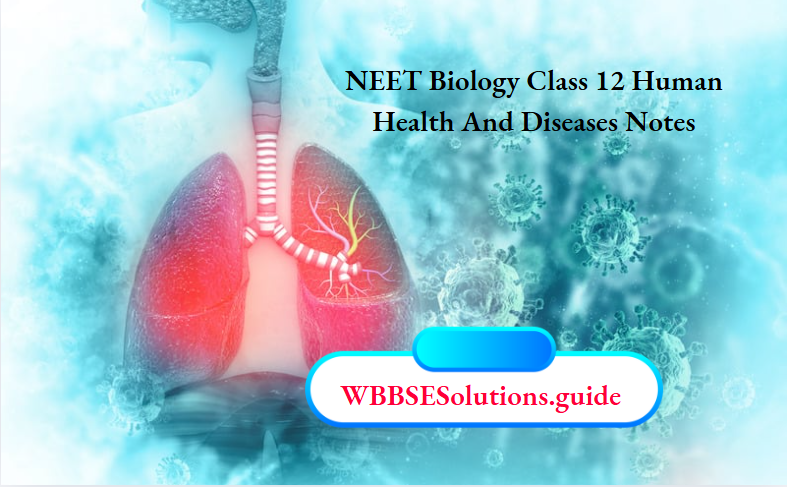Human Health And Diseases
Health:
Health is a state of complete physical, mental and social well-being. Health is affected by genetic disorders, infections, change in life style (food, water, rest, exercise, habits etc). Mind influences the immune system (through neural and endocrine systems).
- When the functioning of organs or systems of the body is adversely affected, it is called a disease.
- Diseases may be infectious (transmitted from one person to another) or non-infectious.
- Disease-causing organisms are called Pathogens. Parasites are pathogens as they harm the host
Read And Learn More: NEET Biology Class 12 Notes
Common Infectious Diseases In Man
1. Bacterial Diseases:
- Typhoid: Pathogen is Salmonella typhi.
- Mode of transmission: It enters small intestine through food and water and migrates to other organs via blood.
- Symptoms: Sustained high fever (39o-40o C), weakness, stomach pain, constipation, headache & loss of appetite. Intestinal perforation and death may occur. Widal test is used for confirmation of the disease.
- Pneumonia: Pathogen is Streptococcus pneumoniae and
- Haemophilus influenzae: It infects lung alveoli. The alveoli get filled with fluid leading to respiratory problems.
- Mode of transmission: Inhaling the droplets/aerosols released by an infected person. Sharing glasses and utensils with an infected person.
- Symptoms: Respiratory problems, fever, chills, cough, headache. In severe cases, lips and fingernails turn grey to bluish colour.
” human health and disease”
2. Viral Diseases:
- Common cold: The Pathogen is Rhinoviruses. It infects the nose and respiratory passage but not the lungs.
- Mode of transmission: Inhaling droplets resulting from cough or sneezes. Through contaminated objects.
- Symptoms: Nasal congestion and discharge, sore throat, cough, hoarseness, headache, tiredness etc. Last for 3-7 days.
3. Protozoan Diseases:
- Malaria: Pathogen is Plasmodium sp. (P. vivax, P.malariae and P. falciparum). Most serious (malignant) malaria is caused by P. falciparum.
- Mode of transmission: By female Anopheles mosquito.
- Symptoms: Haemozoin (a toxin released by Plasmodium) causes chill and high fever recurring every 3-4 days
- Amoebiasis (Amoebic dysentery): Pathogen is Entamoeba histolytica
- Mode of transmission: Houseflies (mechanical carriers) transmit parasites from faeces to food & water.
- Symptoms: Constipation, abdominal pain and cramps, stools with excess mucous and blood clots.
Human Health And Disease Class 12 Disease Chart
Life Cycle Of Plasmodium:
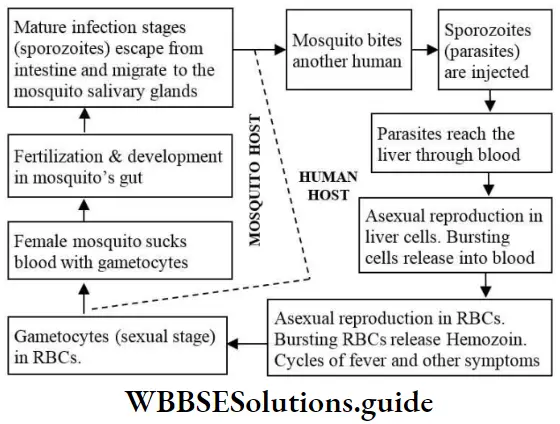
Class 12 Biology Notes For Neet
4. Helminth Diseases:
- Ascariasis: Pathogen is Ascaris (Intestinal parasite).
- Mode of transmission: Soil, water, vegetables, fruits etc.
- contaminated with faeces containing eggs of parasites.
- Symptoms: Internal bleeding, muscular pain, fever, anaemia and blockage of intestinal passage.
- Filariasis (Elephantiasis): Pathogen is Filarial worms or Wuchereria (W. bancrofti & W. malayi).
- Mode of transmission: Bite of female Culex mosquito.
- Symptoms: Filarial worms live in lymphatic vessels (usually of lower limbs). It causes chronic inflammation of the organs in which they live for many years. Limbs and genital organs may be deformed.
NEET Biology Class 12 Human Health and Diseases Notes
5. Fungal Diseases:
- Ringworms: Pathogens are Microsporum, Trichophyton and epidermophyton. They are seen in the groin, b/w toes etc.
- Mode of transmission: From soil or by using towels, cloths, comb etc. Heat and moisture help fungi to grow.
- Symptoms: Dry, scaly lesions on skin, nails, scalp etc. Intense itching.
Human Health and Diseases NEET Notes
Prevention And Control Of Diseases
Personal hygiene: Keep the body clean. Use clean drinking water, food etc.
Public hygiene: Proper disposal of wastes and excreta.
- Periodic cleaning and disinfection of water reservoirs, pools, cesspools and tanks.
- Avoid contact with infected persons or their belongings (to control air-borne diseases).
- Standard practices of hygiene in public catering.
- Control and eliminate the vectors (For example, Mosquitoes).
- Avoid stagnation of water.
- Regular cleaning of household coolers.
- Use of mosquito nets.
- Introduce larvivorous fishes like Gambusia in ponds.
- Spraying insecticides in ditches, drainage and swamps.
- Provide doors and windows with wire mesh.
These precautions can avoid vector-borne diseases like Malaria, Filariasis, Dengue and Chikungunya.
Class 12 Biology Notes For Neet
Immune System
- It is the system that gives immunity to the body.
- It plays a role in allergic reactions, auto-immune disease and organ transplantation.
- It includes lymphoid organs, tissues, cells & antibodies.
“human health and disease class 12 short notes “
Lymphoid Organs
These are the organs where the origin, maturation & proliferation of lymphocytes occur. It is 2 types
- Primary and
- Secondary.
1. Primary lymphoid organs:
Class 12 Biology Human Health And Disease Notes
- Here, immature lymphocytes differentiate into antigensensitive lymphocytes. E.g. Bone marrow & thymus.
- Bone marrow is the site of the formation of blood cells.
- The thymus is large during birth but gradually reduces in size and becomes very small size in puberty.
2. Secondary lymphoid organs:
- The organs, to which matured lymphocytes migrate, interact with antigens and then proliferate to become effector cells.
- Examples are the spleen, lymph nodes, tonsils, Peyer’s patches, Mucosal associated lymphoid tissue (MALT) and appendix.
- Spleen: Bean-shaped organ. Contains lymphocytes and phagocytes. It removes worn-out RBCs & microorganisms from blood. It is a reservoir of erythrocytes in the foetus.
- Lymph nodes: Found in the lymphatic system. They trap microorganisms or other antigens. Trapped antigens activate lymphocytes and cause an immune response.
- MALT: Located within the lining of respiratory, digestive & urinogenital tracts. It constitutes 50% of lymphoid tissue.
Class 12 Biology Notes For Neet
Immunity
It is the ability of the immune system to fight the pathogens. It is 2 types
- Innate and
- Acquired.
NEET Biology Human Health and Diseases Important Notes
1. Innate (inborn) immunity: It is the non-specific immunity present at the time of birth.
It includes 4 types of Barriers:
- Physical barriers: Example, Skin (Prevent entry of foreign bodies), Mucus coating of the respiratory, gastrointestinal and urogenital tracts to trap microbes.
- Physiological barriers: For example, gastric HCl, saliva, tears etc.
- Cellular barriers: Phagocytes like WBC [For example, Neutrophils or Polymorphonuclear leukocytes (PMNL), monocytes and natural killer lymphocytes], macrophages etc.
- Cytokine barriers: Virus-infected cells secrete proteins called interferon which protect non-infected cells from further viral infection.
Biology Class 12 Notes For Neet
2. Acquired immunity: It is pathogen-specific immunity developed during a lifetime.
- It is characterized by memory, i.e. during the first encounter with a pathogen, the body produces a primary response in low intensity.
- A second encounter of the same pathogen causes a secondary (anamnestic) response in high intensity.
- Primary and secondary immune responses are carried out with B-lymphocytes (B-cells) and T-lymphocytes (T-cells).
- B-lymphocytes: Produce antibodies.
- T-lymphocytes: Help B-cells to produce antibodies
Human Health And Disease Class 12 Disease Chart
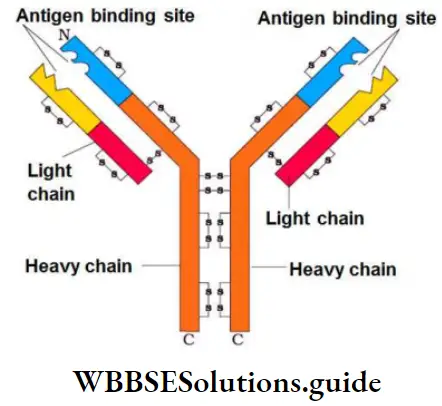
Human Health and Diseases Class 12 NEET Key Concepts and Summary
- Structure of an antibody molecule: An antibody has 4 polypeptide chains: 2 light chains and 2 heavy chains (H2L2).
- Types of antibodies: IgG, IgA, IgM, IgE and IgD.
“class 12 ch 8 bio notes “
Types of Acquired Immune Response
Humoral immune response/Antibody-mediated immunity (AMI): It is the immune response mediated by antibodies. Antibodies are found in blood plasma. So called a Humoral immune response.
Biology Class 12 Notes For Neet
Cell-mediated response / cell-mediated immunity (CMI):
- It is the immune response mediated by T-lymphocytes (T cells).
- The body can differentiate ‘self’ and ‘non-self’ and the CMI causes Graft rejection.
- Tissue matching & blood group matching are essential before undertaking any graft/ transplant.
- After this, the patient should take immuno-suppressants all his life.
Types of Acquired Immunity: Acquired immunity is 2 types
- Active and
- Passive.
1. Active immunity:
It is the immunity in which antibodies are produced in a host body when the host is exposed to antigens (for example, living or dead microbes or other proteins).
Biology Class 12 Notes For Neet
It is a slow process. It is produced in 2 ways:
- Natural Active Immunity: It is developed during natural infection by microbes.
- Artificial Active Immunity: It is developed by injecting the microbes deliberately during immunization.
2. Passive immunity: Here, readymade antibodies are directly given to the body.
It is 2 types:
- Natural Passive Immunity: For example
- Antibodies (IgG) from mother → Placenta → Foetus
- Antibodies (IgA) in colostrum → infants
- Artificial Passive Immunity: For example, Anti-tetanus serum (ATS)
Class 12 Biology Human Health And Disease Notes
Immunization
This is based on the ‘memory’ of the immune system. 2 types:
1. Active Immunization (Vaccination):
In this, the preparation of vaccine (antigenic proteins of pathogen or inactivated pathogen) is introduced into the body. It results in the development of antibodies.
- During actual infection, the antibodies neutralize antigens.
- The vaccines also generate memory B and T-cells. They recognize the pathogen quickly.
- Example, Polio vaccine, Hepatitis B vaccine, DPT vaccine etc.
- Vaccines are produced using DNA recombinant technology (For example, Hepatitis B vaccine produced from Yeast).
2. Passive Immunization:
- It is the direct injection of pre-formed antibodies or antitoxin. It requires for quick immune response.
- For example, Immunization against Tetanus, snake venom etc
Class 12 Biology Human Health And Disease Notes
Allergies
- It is the exaggerated response of the immune system to certain antigens present in the environment.
- Allergens: Substances causing allergy. E.g. mites in dust, pollens, animal dander, fur etc.
- Antibodies produced against the allergens are of IgE type.
- Allergy is due to the release of chemicals like histamine and serotonin from the mast cells.
- Symptoms: Sneezing, watery eyes, running nose, difficulty
- in breathing, skin rashes etc.
- Determination of cause of allergy: The patient is exposed to or injected with very small doses of possible allergens, and the reactions are studied.
- Treatment: Drugs like anti-histamines, adrenaline and steroids quickly reduce the symptoms of allergy.
- Asthma: Asthma is a respiratory disease due to allergy.
- Modern-day lifestyle results lowering of immunity and more sensitivity to allergens.
Autoimmunity
- It is the condition in which the body attacks self-cells due to genetic and other unknown reasons.
- It leads to auto-immune disease. For example, Rheumatoid arthritis.
“common human diseases “
AIDS (Acquired Immuno Deficiency Syndrome):
- It is a deficiency of the immune system.
- It is caused by HIV (Human Immunodeficiency Virus), a
- retrovirus having RNA genome.
- AIDS was first reported in America (1981).
Class 12 Biology Human Health And Disease Notes
1. Transmission:
- Sexual contact with an infected person.
- Transfusion of contaminated blood & blood products.
- Sharing of infected needles.
- From the infected mother to her child through the placenta.
NEET Biology Class 12 Chapter Human Health and Diseases Detailed Notes
2. High-risk people of getting HIV:
- Individuals with multiple sexual partners.
- Drug addicts who take drugs intravenously.
- Individuals who require repeated blood transfusion.
- Children born to an HIV-infected mother.
3. HIV does not spread by touch or physical contact. It spreads only through body fluids.
4. There is a time lag (from a few months to 5-10 years) between the infection and the appearance of symptoms.
Human Health And Disease Class 12 Disease Chart
5. Replication of retrovirus:
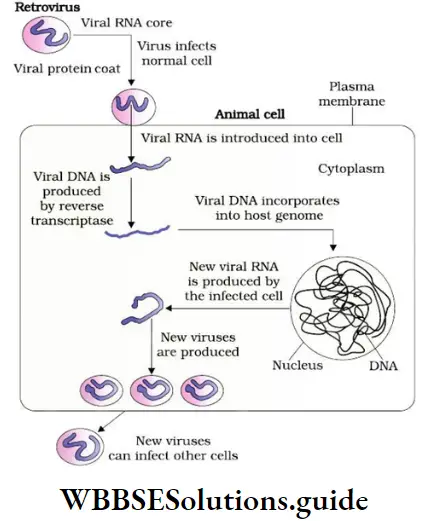
“human health and disease notes pdf download “
6. Life cycle:
HIV enters the body → To macrophages (acts as HIV factory) → RNA genome replicates in the presence of Reverse transcriptase to form viral DNA → Viral DNA incorporates into host DNA → Infected cells produce virus particles → HIV enters into helper T-cells (TH) →Replicates & produce progeny viruses → Attack other helper T-cells → T-cells decrease → Weaken immunity.
7. HIV infected person may be infected with Mycobacterium, viruses, fungi and parasites like Toxoplasma.
8. Diagnosis: ELISA test (Enzyme-linked immuno-sorbent Assay).
9. Treatment: Anti-viral drugs are partially effective. They can only prolong the life of the patient.
Human Health And Disease Class 12 Notes Neet
10. Prevention of AIDS:
- Educate people about AIDS.
- Making blood (from blood banks) safe from HIV.
- Use of disposable needles and syringes.
- Advocating safe sex and free distribution of condoms.
- Controlling drug abuse.
- Regular check-ups for HIV in susceptible populations.
NEET Study Material for Human Health and Diseases Chapter
Cancer
- Cancer is an abnormal and uncontrolled multiplication of cells resulting in the formation of tumours (masses of cells).
- Normal cells show contact inhibition (contact with the other cells inhibits their uncontrolled growth). Cancer cells do not have this property.
Types of Tumours:
- Benign tumours: Confined to the place of their origin. They do not spread to other parts. Cause little damage.
- Malignant tumours: Mass of proliferating cells (neoplastic or tumour cells) that grow rapidly, invade and damage the surrounding normal tissues. Due to active division and growth, they starve normal cells by competing for nutrients.
Cells sloughed from tumours reach other sites via blood where they form a new tumour. This is called metastasis.
Class 12 Biology Human Health And Disease Notes
Cancer Causes (Carcinogens):
- Physical agents: Example, Ionizing radiations like X-rays and gamma rays and non-ionizing radiations like UV.
- Chemical agents: Tobacco smoke (a major cause of lung cancer), vinyl chloride, caffeine, nicotine, mustard gas etc.
- Biological agents: For example, oncogenic viruses, c-onc (cellular oncogenes or proto-oncogenes) etc. When C-onc in normal cells is activated, the cells become oncogenic.
Cancer detection and diagnosis:
Human Health And Disease Class 12 Notes Neet
- Biopsy: A thin piece of the suspected tissue is stained and examined under a microscope (histopathological studies).
- In case of leukaemia: Biopsy & histopathological studies.
- Blood & bone marrow tests for increased cell counts.
- Radiography (use of X-rays): CT (Computerized tomography) scan and MRI (Magnetic Resonance Imaging).
- Use of Antibodies against cancer-specific antigens.
- Molecular biology technique: To detect cancer-related genes. Such individuals should avoid carcinogens (for example, tobacco smoke).
Cancer Treatment:
- Radiotherapy: Tumour cells are irradiated lethally, without damaging surrounding normal tissues.
- Chemotherapy: Use of chemotherapeutic drugs. Many drugs have side effects like hair loss, anaemia etc.
- Immunotherapy: The patients are given biological response modifiers (for example, αinterferon) which activate their immune system and help in destroying the tumour.
- Surgery.
- Most cancers are treated by a combination of surgery, radiotherapy and chemotherapy
Human Health And Disease Class 12 Notes Neet
Drugs Smoking And Alcohol Abuse
Drugs (opioids, cannabinoids & coca alkaloids):
Opioids
- They bind to specific opioid receptors in the, for example, CNS and gastrointestinal tract. morphine, heroin, brown sugar.
- Morphine: Morphine is extracted from the latex of the poppy plant, Papaver somniferum. It is a sedative and painkiller, and useful for surgery.
“human body and diseases “
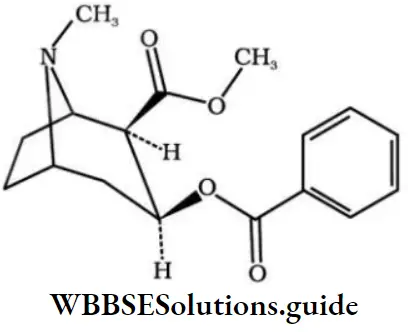
Human Health and Diseases Class 12 NCERT Notes for NEET
- Heroin: Heroin(smack or diacetylmorphine) is a white, odourless, bitter crystalline compound. It is obtained by acetylation of morphine. It is taken by snorting and injection. Heroin is a depressant and slows down body functions.
Human Health And Disease Notes Class 12th
Cannabinoids
- They interact with cannabinoid receptors in the brain.
- Generally taken by inhalation and oral ingestion.
- Natural cannabinoids are obtained from inflorescences of Cannabis sativa (Hemp plant). Its flower tops, leaves & resin are used to make marijuana, hashish, charas & ganja.
- They affect the cardiovascular system.
- Cannabinoids are abused by some sportspersons.
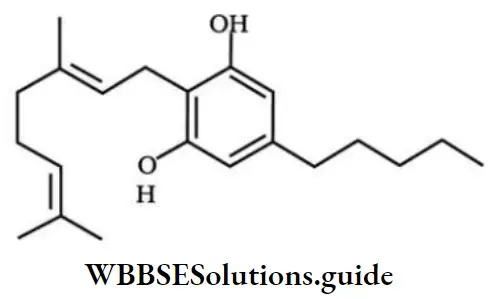
Coca alkaloid or cocaine (coke or crack)
- It is obtained from the coca plant Erythroxylum coca.
- It interferes with the transport of the neurotransmitter dopamine.
- Cocaine is usually snorted.
- It stimulates CNS producing euphoria & increased energy.
- Excessive dosage of cocaine causes hallucinations.
- Atropa belladonna & Datura are also hallucinogenic plants.
Human Health And Disease Notes Class 12th
Drugs like barbiturates, amphetamines, benzodiazepines, etc. are used as medicines to treat mental illnesses like depression and insomnia. But their abuse results in impairment of physical, physiological or psychological functions.
Smoking
- Tobacco is smoked, chewed or used as a snuff.
- Tobacco contains nicotine (an alkaloid). It stimulates the adrenal gland to release adrenaline and nor-adrenaline, causing high BP and heart rate.
- Smoking causes cancers of the lungs, urinary bladder and throat, bronchitis, emphysema, coronary heart disease, gastric ulcer etc. Tobacco chewing causes oral cancer.
- Smoking increases CO2 content in blood and reduces oxyhaemoglobin. This causes O2 deficiency in the body.
Adolescence
- Adolescence is a period’ and ‘a process’ during which a child becomes mature in terms of his/her attitudes and beliefs for effective participation in society.
- Adolescence is a bridge linking childhood and adulthood (period of 12-18 years of age). It is very vulnerable phase of mental and psychological development.
Causes of drug/alcohol use in Adolescence:
- Curiosity and Experimentation.
- Need for adventure and excitement.
- To escape facing problems.
- Stress from pressure to excel in academics or examinations.
- Television, movies, newspapers, internet etc.
- Unstable or unsupportive family structures & peer pressure.
Human Health And Disease Notes Class 12th
Addiction and Dependence
Addiction:
- It is a psychological attachment (euphoria and a temporary feeling of well-being) with drugs and alcohol.
- With repeated use of drugs, the tolerance level of the receptors increases. Thus the receptors respond only to higher doses leading to greater intake and addiction.
Immunity, Vaccination, and Common Diseases NEET Notes
Dependence:
- It is the tendency of the body to manifest a characteristic and unpleasant withdrawal syndrome if the regular dose of drugs/alcohol is abruptly discontinued.
- This results in anxiety, shakiness, nausea and sweating.
- Dependence leads to social adjustment problems.
“human health and welfare “
Effects of Drug/alcohol abuse:
- Reckless behaviour, vandalism and violence.
- Coma and death due to respiratory failure, heart failure or cerebral haemorrhage.
- Drugs in combination with alcohol may lead to death.
- Damage of the nervous system and liver cirrhosis.
- Mental and social distress to family and friends.
- Social problems like stealing and the spread of infectious diseases (for example, AIDS, hepatitis B).
- The use of drugs and alcohol by pregnant women affects the foetus (Foetal alcohol syndrome or FAS).
- Loss of sexual drive and necrospermia.
- Misuse of drugs by athletes (for example, Narcotic analgesics, anabolic steroids, diuretics and certain hormones to increase muscle strength and bulk and to promote aggressiveness).
Warning signs of drug/alcohol abuse in the Adolescence period:
- Drop in academic performance and absence from school.
- Lack of interest in personal hygiene.
- Withdrawal and isolation.
- Depression, fatigue, aggressive and rebellious behaviour.
- Change in sleeping and eating habits.
- Fluctuations in weight, appetite etc.
- Loss of interest in hobbies.
- Deteriorating relationships with family and friends.
Side effects of anabolic steroid abuse:
Human Health And Disease Notes Class 12th
1. In males:
- Acne.
- Mood swings & depression.
- Increased aggressiveness.
- Reduced testicles.
- Decreased sperm.
- Kidney & liver dysfunction.
- Breast enlargement.
- Premature baldness
- Enlargement of prostate gland.
2. In females:
- Masculinisation
- Mood swings & depression
- Increased aggressiveness
- Excessive hair growth
- Abnormal menstrual cycle
- Deepening of voice
- Enlargement of clitoris
“human health and welfare “
In adolescent males & females: Severe facial and body acne, premature closure of the growth centres of the long bones resulting in stunted growth.
Prevention and control:
- Avoid undue peer pressure.
- Education and counselling.
- Seeking help from parents and peers.
- Looking for danger signs.
- Seeking professional and medical help.
- Psychologists and psychiatrists.
- De-addiction and rehabilitation programs.

